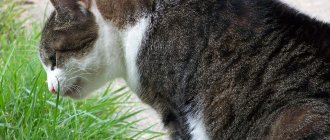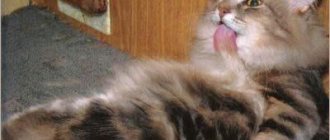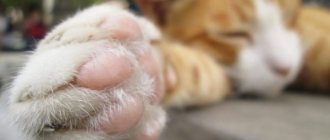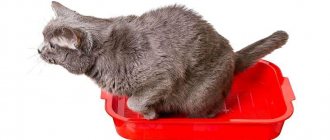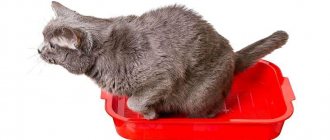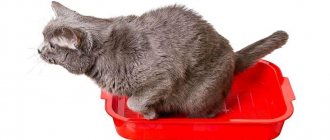Cats with gastrointestinal problems are among the most common patients in veterinary clinics. This makes them a constant concern for guardian cats. Digestive diseases have very characteristic signs and symptoms, but distinguishing between them is not always easy. This is because similar symptoms can be present in very different diseases, meaning veterinarians must be skilled in diagnosing them.
Although the causes of gastrointestinal disease in cats are varied, there are certain references that can give us a clue. Vomiting and diarrhea are the most obvious symptoms of indigestion, but we need to look at the accompanying symptoms to better understand the problem. If you see that your cat is not eating and is vomiting, this gives us an idea of what the problem may be.
The appearance of watery vomiting
An animal can vomit not only clear liquid. The water sometimes contains pieces of food, wool, bile, and blood.
In any case, the gag reflex is a reaction to nausea. The stomach tries to get rid of foreign objects, excess food, water. But these are not the only factors that make cats vomit.
Deep swallowing movements with rapid breathing that accompany vomiting are an instinctive manifestation of the body.
The brain center gives signals for such actions. He also first receives signals from the nerve endings affected by the problem that has arisen.
Avoid and treat vomiting with white foam
After identifying the most common reasons why a cat vomits white foam, we will see some recommendations on what we can do to prevent this situation and how to deal with this situation. These are the following:
- Vomiting is a symptom that should not be left untreated by contacting our veterinarian.
- It is recommended that you write down the symptoms we observe. In case of vomiting, you should look at its composition and frequency. This will help the veterinarian make a diagnosis.
- We must provide our cat with an adequate diet to meet her nutritional needs, avoiding foods that may make her feel unwell or trigger an allergic reaction.
- We must also store it in a safe environment to prevent it from being ingested by a potentially dangerous item.
- Regarding hairballs, brush your cat, especially during shedding season, as this will help get rid of all the dead hair that is about to fall out.
- It is important to keep a calendar of internal and external deworming, even if the cat does not have access to the outside. Our veterinarian will give us the most appropriate recommendations based on our circumstances.
- If a cat has vomited once and is in good spirits, we can wait and watch before contacting the vet. On the contrary, if the vomiting recurs, we see other symptoms, or our cat is decomposed, we should go straight to the vet without trying to treat it ourselves.
- Finally, from the age of 6-7 years, it is convenient that at least once a year we take our cat to the veterinary clinic for a full examination, including analytics. This is justified because with such control, some of the diseases we have talked about can be diagnosed at an early stage, which allows us to begin treatment before the first symptoms appear.
Possible reasons
A pet can vomit for any reason (just like a person).
The main factors are classified into the following groups:
- physiological characteristics;
- poisoning and infections;
- internal illnesses.
The first group can be considered the most harmless - vomiting is short-term. Other reasons provoke prolonged nausea. And this is already a reason to start treating your pet.
Physiological prerequisites
Vomiting can occur due to the anatomical structure of the cat's stomach. But in most cases, physiological manifestations are associated with other factors.
| Factors | Peculiarities |
| Hairballs | Sometimes cats themselves provoke vomiting by eating grass. This is necessary to remove from the stomach the hairballs that have accumulated there when combing out with the tongue. |
| Binge eating | The nerve receptors in the stomach are sensitive to excessive pressure from excess food. What the body is unable to process is rejected back, so there will be pieces of food in the vomit. |
| Quick swallowing | A hungry cat sometimes swallows food without chewing it. The digestive system does not have time to adjust to the process and pushes out food along with water |
| Pregnancy | In the morning, a cat may feel sick due to symptoms of pregnancy toxicosis. The expectant mother does not have time to eat, so she mostly vomits clear liquid |
| Motion sickness | Cats have problems with the vestibular system. It is not surprising that a pet may vomit clear liquid during (or after) driving a car. |
Sometimes pets drink a lot of water because they are thirsty, if, for example, they have eaten the “wrong” food - smoked, spicy, salty.
A foreign object or plastic wrapper from sausage may become lodged in the stomach. Then the animal deliberately drinks a large amount of liquid in order to deliberately provoke vomiting.
Diseases
If a cat vomits systematically, and the situation is not related to physiology, you need to look for the problem inside the body. There are a number of serious diseases that cause pets to vomit (and not just water).
| Name | Peculiarities | Symptoms |
| Hyperthyroidism | Cats have problems with the thyroid gland, and it’s difficult to detect. | Nausea is accompanied by increased salivation, rashes on the face, and greasy fur. |
| Pancreatitis | The disease develops due to improper feeding. Vomiting is usually caused by severe attacks of pain | The cat is in a tense position and does not allow anyone to touch its stomach. Vomiting may be accompanied by loose stools |
| Gastritis | The urge appears on an empty stomach in the morning. The cause is irritation of the gastric mucosa | The rejected water contains white foam |
| Liver problems | Your cat vomits frequently, regardless of food intake. | The animal vomits not clean water: the liquid contains bile |
| Oncology | Cancer in cats appears in adulthood. If a neoplasm appears in the stomach, the animal stops eating and vomits a clear liquid. Nausea is also caused by a tumor localized in the brain | Blood clots may be seen in the vomit. Due to lack of appetite, your pet loses weight. Vomiting water is accompanied by diarrhea |
If your pet is vomiting continuously, and after water comes out undigested food, then bile, and all this is accompanied by a foul odor, there is a suspicion of intestinal obstruction.
A cat can also vomit due to inflammatory processes in the uterus, kidney disease, and ear disease.
Common Causes
In addition to diseases of the internal organs, there are other factors that cause nausea in an animal:
- a cat vomits when poisoned by a low-quality or harmful product;
- the cause of vomiting due to toxins missing from the body may be plants containing alkaloids;
- the animal fell ill with panleukopenia, having picked up a deadly virus;
- helminths can cause intoxication.
In case of food infections and poisoning, the cat vomits large amounts of water mixed with bile, undigested food, and foam.
The animal is in a depressed state and takes unnatural poses. Symptoms often include diarrhea with a strong unpleasant odor.
Why does my cat feel sick and vomit?
Your veterinarian will ask many questions to determine why your cat is vomiting.
Questions could be:
- Have you recently changed your cat's diet?
- Have you started taking any prescription or over-the-counter medications?
- What diet, including all treats, is your cat on?
- Do you have other cats in the house, and if so, do they vomit too?
- Is your cat indoors and/or outdoors?
- How often does your cat vomit and what does it look like?
- Does your cat keep eating?
- Does your cat have other symptoms, such as diarrhea and/or weight loss?
- How long has your cat been vomiting?
There are several possible causes of vomiting in cats, and these questions will help point your veterinarian in the right direction. Possible causes of vomiting in cats can be divided into two categories: gastrointestinal causes and non-gastrointestinal causes.
Gastrointestinal causes of vomiting in cats
- Indiscretion in nutrition
- Foreign bodies
- Parasites
- Diet hypersensitivity
- Inflammatory bowel disease
- Constipation
- Cancer
- Ulceration
- Ingestion of toxins (ethylene glycol, chocolate, pesticides, etc.)
Causes of vomiting in cats not related to the gastrointestinal tract
- Pancreatitis
- Kidney disease
- Liver disease
- Diabetes
- Feline infectious peritonitis
- Cancer
- Neurological diseases
How to help an animal
Before starting treatment, you need to make sure that the vomiting is caused by a serious reason. If there are hairballs in the vomit and nausea was an isolated incident, you can do nothing.
When a cat vomits after eating, you need to examine the contents of the mass. If there is undigested food there, then this is most likely physiology, and not problems with the intestines. But if concomitant symptoms are added to vomiting water, then therapeutic measures should be taken or contact a veterinarian.
Drugs
Medicines are selected depending on the cause of vomiting in the animal:
- If there is a suspicion of poisoning, it is recommended to dilute Enterosgel (Atoxil) at the rate of 2 ml per 1 kg of pet’s body weight.
- When vomiting on an empty stomach with foamy water, it is recommended to give Almagel.
- If vomiting is not severe, you can use Regidron.
- For frequently recurring urges, an intramuscular injection of No-shpa or Cerucal is given (0.1 ml per 1 kg of weight).
In cases where the cat is not very tense and the accompanying symptoms are not very pronounced, you can use traditional methods of treatment.
Folk remedies
An alternative to drug therapy are folk remedies:
- In case of intoxication, it is recommended to give the cat a large amount of liquid to provoke additional vomiting.
- Give your pet 1 tbsp several times a day. decoction of flaxseeds or chamomile infusion.
During the first hours, the cat is not fed, then it is switched to a gentle diet - boiled rice with lean chicken or special food (in small portions). Habitual food is introduced gradually .
What does your cat's vomit look like?
It's important to know what your cat's vomit looks like, as various medical conditions can cause a more distinct appearance of vomiting. Here are some examples of vomit color/consistency and possible causes for each.
Bile/yellow
The cat will vomit bile on an empty stomach. This can happen if you only feed your cat in the morning and she doesn't eat for 24 hours, or it can happen if cats are anorexic.
Food stimulates the gallbladder to contract, but when the gallbladder does not contract, bile can return to the small intestine and stomach.
Blood
Blood may be seen in ulcers, or if your cat vomits several times in a row, this can irritate the lining of the stomach and esophagus due to the increased acid content.
Blood may also be present when there is a clotting disorder, which occurs with certain diseases and certain toxins (such as rat poisoning).
White foam
White foam in cat vomit is often observed due to inflammation of the lining of the stomach and/or small intestine for various reasons.
Water/clear liquid
If your cat is vomiting clear liquid, it could be liquid stomach contents or your cat has drunk too much water.
There are many possible medical conditions that could cause cats to drink too much water, including diabetes and kidney disease.
Worms
The most common type of worms found in cats vomiting are roundworms. If your cat vomits a worm, it is important to take it to your veterinarian so they can deal with the problem accordingly.
Food
Cats that eat too much or too quickly may regurgitate their food, which is usually tube-shaped. Cats may also vomit food if they start vomiting soon after eating, if there is a foreign body blocking the food from moving into the small intestine, or if they have a food allergy.
Hairballs
Cats can sometimes vomit hairballs, especially cats that groom them too much or cats with long hair.
Brown liquid
This usually indicates digested blood along the digestive tract and manifests as ulcerations, foreign bodies or even hairballs in the intestines.
Green vomit
If your cat's vomit is green, it usually indicates that the food or substance was brought in from the small intestine. A mixture of vomit and bile may change color to green.
Slime
Mucus is usually seen when your cat spits up and doesn't vomit. If you see mucus, it is very important to determine whether your cat is actually vomiting or regurgitating.
Treatment of vomiting in kittens
In small pets, the digestive system is not fully formed, so vomiting can be caused by dysfunction of the sphincter, which does not allow the stomach to empty normally.
Regurgitation can also occur for another reason: pathology of the muscle located between the esophagus and the stomach. With this diagnosis, the kitten is given only pureed food in small portions.
Cat vomiting with other symptoms
Often when cats vomit, they also have other symptoms. Describing all of your cat's symptoms to your veterinarian will be important in determining the correct diagnosis or treatment.
Your cat is vomiting and won't eat.
Cats often don't want to eat if they feel sick. You may see this in a variety of conditions including foreign bodies, kidney and liver disease, severe diabetes, inflammatory bowel disease, etc.
Your cat is vomiting and constipated
If your cat hasn't had a bowel movement in a couple of days and is trying to walk, he's probably constipated. This can cause contents to accumulate in the small intestine and stomach, causing nausea and vomiting in the cat.
Your cat is vomiting and has diarrhea.
This combination of symptoms tells us that there is inflammation not only in the stomach, but also in the small and/or large intestine.
Your cat is vomiting and sneezing
If your cat is vomiting and sneezing, he may have contracted a virus (such as coronavirus). Cats that become ill (vomiting) often develop an upper respiratory tract infection.
This is because most cats become infected with certain viruses, such as herpesvirus, as kittens and may behave normally until they become immune.
Your cat is vomiting and drinking a lot
Cats may vomit after drinking large amounts of water. They may also have a medical condition that causes them to drink a lot and vomit, such as kidney disease, diabetes, and cancer.
Your cat is vomiting and pooping on the floor.
Cats may defecate on the floor if they are constipated or have an increased urge to go to the toilet, which is associated with intestinal inflammation and diarrhea.
Signs of water poisoning
The content of hazardous substances in the water that you drink leads to their rapid absorption in the body, so signs of poisoning most often appear in a short time.
If intoxication is associated with the presence of bacteria, then the symptoms are not provoked by the liquid itself - they appear due to the multiplication of the pathogen. The picture of each disease has its own characteristics. For example, with cholera, colorless stools, diarrhea up to 25 times a day, and vomiting are observed. With typhus, a roseate rash appears - spots with blurred edges on the stomach, arms, legs, chest. The latent period of typhus lasts up to two weeks, so the symptoms are not immediately noticeable.
Common symptoms of water poisoning include nausea, vomiting, loose stools, rumbling stomach and increased gas production. Weakness, sweating, drowsiness, increased body temperature, and dizziness are also noted. The accumulation of fluid in tissues leads to an increase in blood volume, changes in blood pressure, tachycardia and other types of heart rhythm disturbances appear. The limbs may swell, urination becomes less frequent, and in some cases, convulsions associated with electrolyte imbalance are possible.
